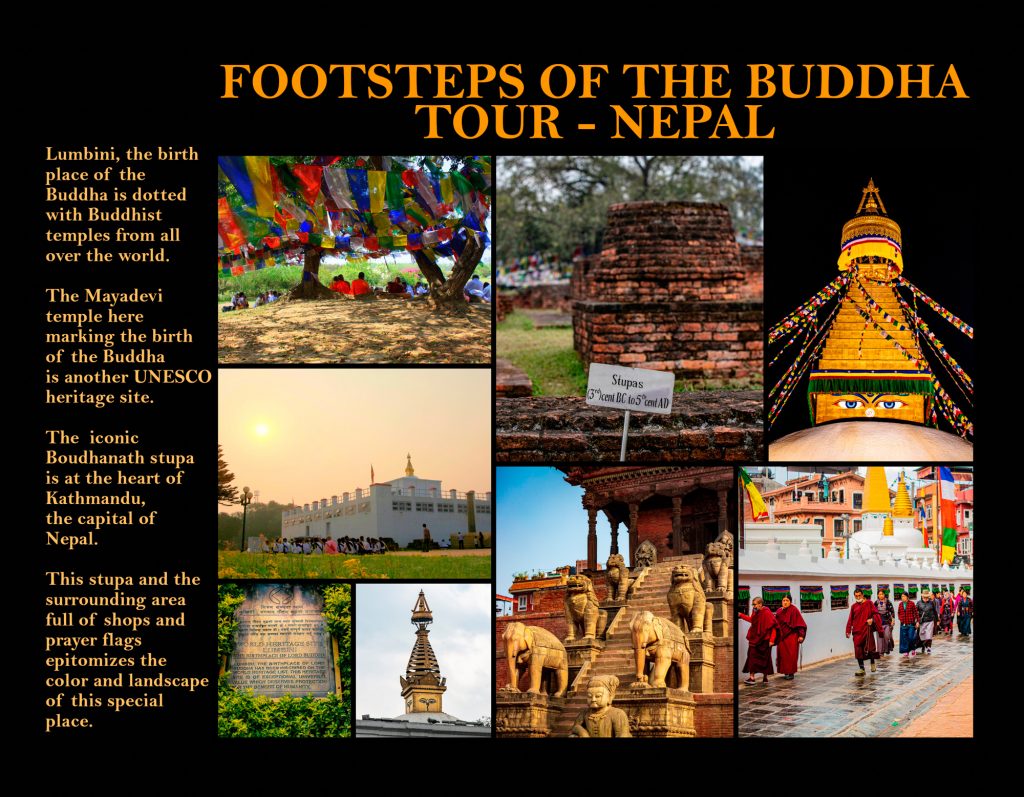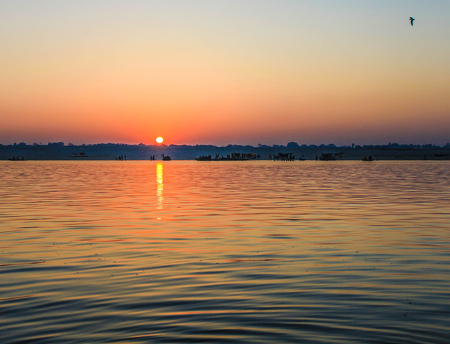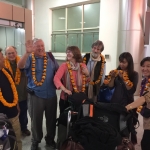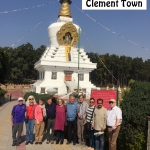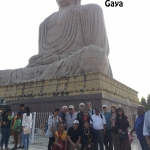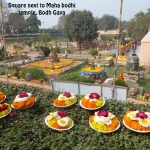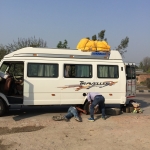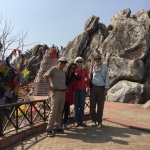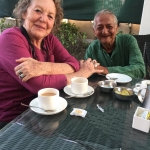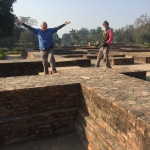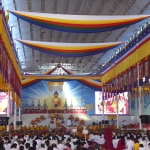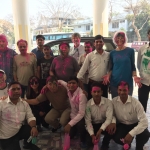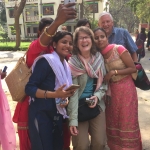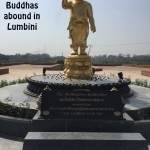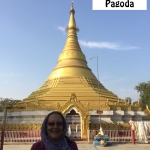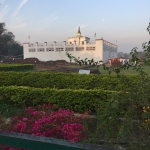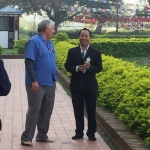Footsteps of the Buddha Plus Sikkim 2020
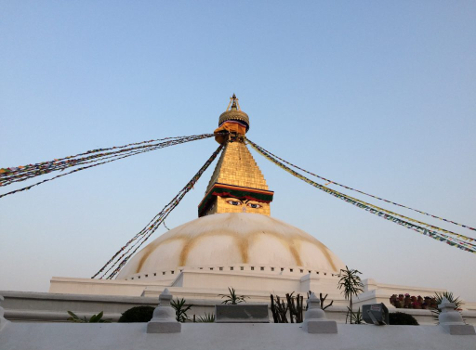 Karma Tensum, Winter Safronoff & Tseten Dorjee
Karma Tensum, Winter Safronoff & Tseten Dorjee
March 02 – March 16, 2020
$3,500 USD per person, double occupancy – including everything except international airfare and personal expenses
Use the above PayPal button to pay an $800 deposit to hold your place.
15 DAY TRIP TO PILGRIMAGE SITES IN BIHAR, PLUS SIKKIM
This year we will do the heart of the Footsteps of the Buddha Tour-with visits to Clement Town, Bodh Gaya, and Sarnath and then head off to the Himalayas in Sikkim! Our hope is to get the best of the sacred Buddhist sites that offer so much inspiration and learning and also experience the Himalayan culture at close quarters with guides who are also our long-time friends and locals of Sikkim.
March 1: Depart US
March 2: Arrival in N.Delhi to discover the inner peace of a city rich with culture, architecture and human diversity, deep with history and totally mesmerizing. The capital of India, Delhi has a historic past and a vibrant present, blending the beauty of the Mughal Empire found in the ancient walled city to ultra-modern skyscrapers and official government buildings.
March 3: Flight from Delhi to Dehra Dun
March 4: Clement Town, Dehra Dun
Clement Town
From Delhi, we will head to Clement Town, in the district of Dehra Dun. Located about 200 miles north, Clement Town is a thriving Tibetan community in exile. Here we have family and life long friends and we will be immersed completely in the Tibetan culture. The settlement is blessed with stupas, monasteries and other Buddhist monuments. The local Tibetan families are our friends and we may even have a meal in someone’s house.
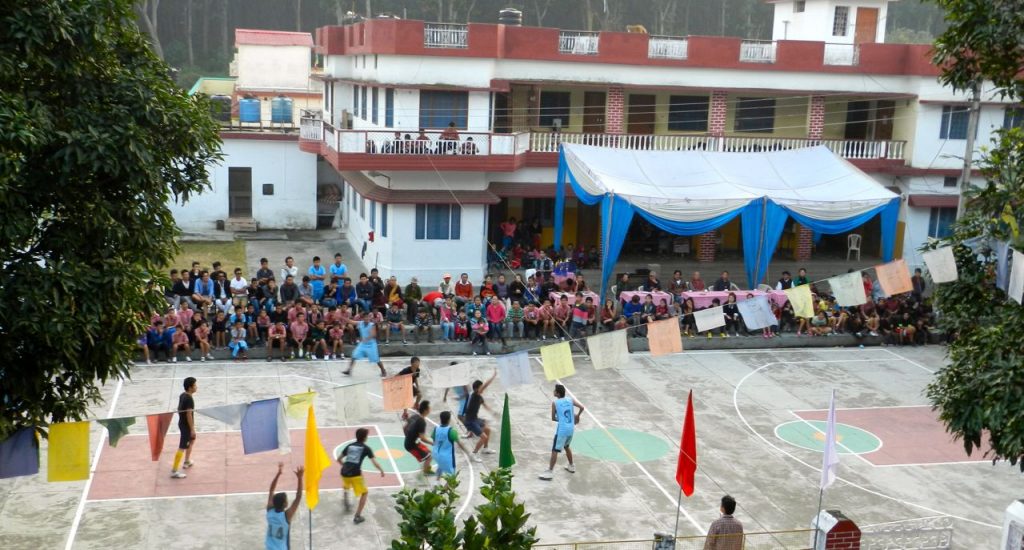
Kyitsel-ling
Clement Town is also the home of Kyitsel-ling Tibetan Children’s Education Center – the education hostel that TCEF helped to found. The group will be very special and honored guests here. Group members who are also TCEF sponsors can connect with their sponsored child or elder. Last year, we made several emotional and heartwarming connections.
Throughout our day with the Tibetan community at Clement Town, we will reconnect with old friends and say hello to the children and elders on our sponsorship programs. At Clement Town, it will all be about connecting the Tibetans with the TCEF board, sponsors and supporters.
March 5: Clement Town to N Delhi by Air, New Delhi to Bodh Gaya by Air
March 6: Bodh Gaya
Located in the Indian state of Bihar, Bodh Gaya is the most sacred place for all Buddhists – the Mecca of Buddhism. This is the place where the Gautam Buddha attained Enlightenment or Nirvana under the Bodhi tree.

Bodh Gaya today is dotted with Buddhist temples from all over the world – but the heart and soul of Bodh Gaya is the Mahabodhi temple – a UNESCO world heritage site. In the inner compound of this holy temple is a bodhi tree – a direct descendant of the tree under which the Buddha became enlightened 2500 years ago. Here, we will breathe the air of spirituality, sit and meditate under the same sacred tree. For some, this sacred experience might sow the seed of a spiritual awakening, for others, it might simply be an opportunity to think about how they can bring some balance and compassion in their own lives.
March 7: Bodh Gaya to Varanasi by Air, Night at Sarnath
We will catch a flight that allows us to visit the famous Dhamekh stupa at Sarnath. This is the place where the Buddha gave his very first teaching. We will sit in quiet meditation and reflexion in the shadow of this holy shrine, offer prayers, find inner peace.
Sarnath
After he received Enlightenment, the Buddha spent the next 45 years teaching and it all began here at Sarnath. Here at the historic Deer Park, he taught his very first sermon and set in motion the ‘Wheel of the Dharma’.
At the site where the Buddha first spoke the words of the Dharma stands a massive stupa called the Dhamekh stupa. The original stupa was constructed by Ashoka. Pilgrims visit this place to circumambulate this sacred stupa and to worship the Buddha. The first discourse of the Buddha was on the ‘Wheel of Law’. The wheel symbolizes samsara – the eternal round of existence which goes on and on, life after life because of ceaseless cravings and desire.
Right in the shadow of the massive and ancient Dhamekh stupa, one can get a sense of the profound message that changed billions of lives, one can reflect on our own ceaseless cravings that bring so much suffering – and take our first steps in letting go – whether it is external ‘stuff’, a bloated ego or emotional negativities. If there is one central and eternal message from the Buddha to take from this sacred site, it is that our cravings and attachments often can be the cause of suffering…. A life of balance, a freeing away of attachments even if it is only material attachment that you can free yourself of, is a great beginning to start a life of balance.
March 8: Varanasi
Varanasi
Varanasi is an ancient and holy city in the northern Indian state of Uttar Pradesh dating to the 11th century B.C. Regarded as the spiritual capital of India, the city draws Hindu pilgrims who bathe in the Ganges River’s sacred waters and perform funeral rites. Along the city’s winding streets are some 2,000 temples, including Kashi Vishwanath, the “Golden Temple,” dedicated to the Hindu god Shiva.
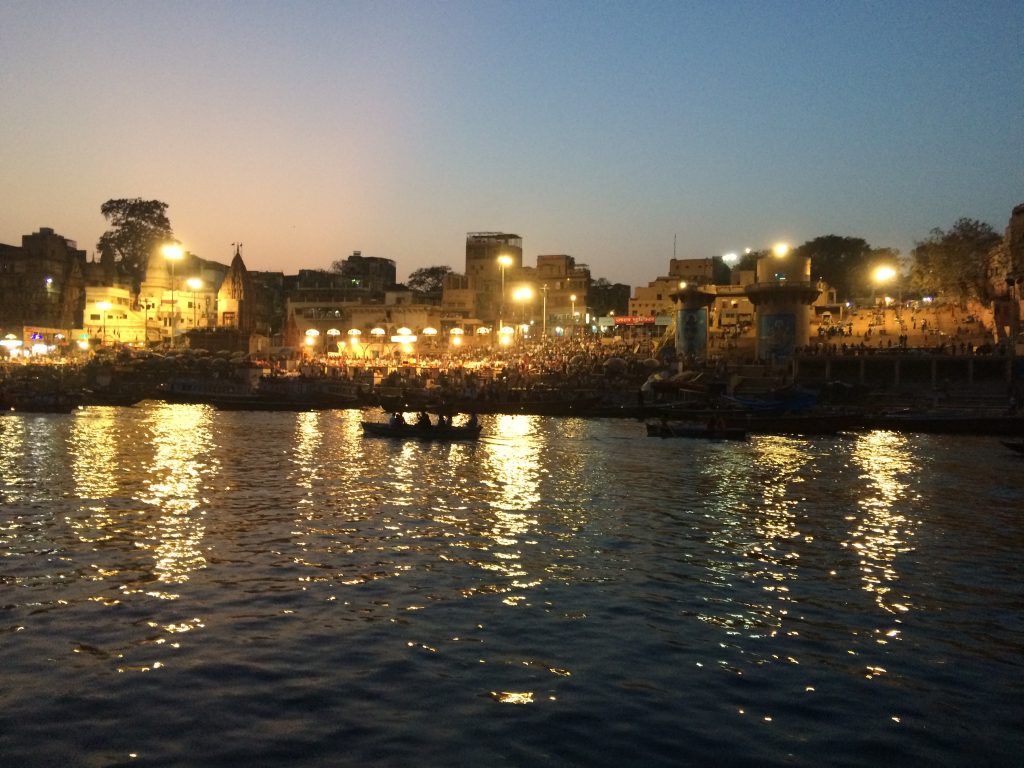
Life on the banks of the Ganges here at Varanasi begins at dawn when thousands of pilgrims come down to the river to wait for the rising sun when the sacred river will cleanse them of their sufferings and wash away their sins. Varanasi is situated on the western bank and has a spectacular view of the rising sun. It is one of the most fascinating cities in India.
March 9 : Varanasi to Bagdogra by Air, Bagdogra to Gangtok by Jeep
March 10: Monastic Tour of Gangtok
There is an amazing collection of Buddhist and Tibetan culture centers in Gangtok. We’ll enjoy the whole day doing a temple tour including the famous Rumtek Monastery, the seat of HH The Karmapa.

March 11: City Tour of Gangtok
We will explore all the other beautiful things Gangtok has to offer aside from the monasteries. We will visit classic scenic spots, waterfalls, flower shows and even some local handicrafts. We’ll just walk, stroll and enjoy Gangtok.
March 12: Tsongo Lake, Gangtok
Today we drive up for a memorable excursion tour to Tsongo Lake (12,400 ft. /39 km), This is one of the highest Himalayan Lake. This beautiful oval-shaped lake is almost 1 km long with its average depth of 50 ft.
We’ll trek to a nearby Tsongo Hill, enjoy the view from that vantage point and then for those who want we can arrange yak rides around the lake.
Back to Gangtok and evening free for M.G Marg. the popular shopping area in Gangtok. Overnight stay in Gangtok.
March 13: Gangtok to Yuksom, via Ravangla
There is a Tibetan settlement. school and carpet weaving center at Ravangla. The carpet center is one of the best places to visit to shop for woven items. Carefully handcrafted and made by Tibetan refugees, the center displays various items such as carpets, shawls etc.
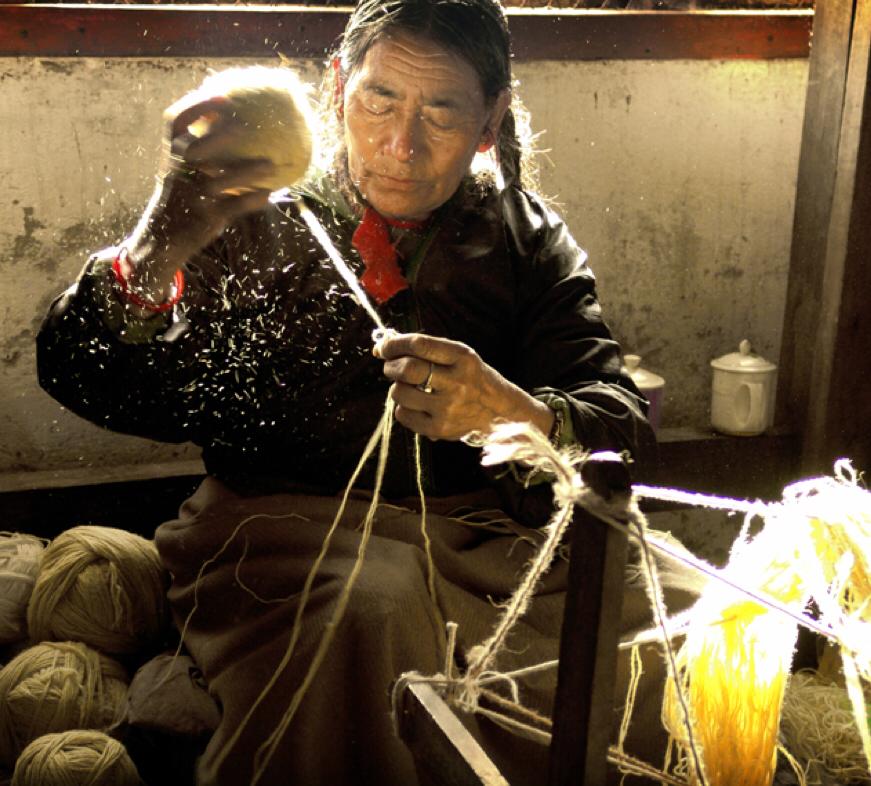
If there is any place on earth where one can see “heaven,” then it has to be Yuksom. Formally referred to as the ‘Gateway to Kangchendzongha’, Yuksom is consecrated by the presence of majestic snow-peaked mountains, monasteries, etc. Yuksom was the ancient capital of Sikkim, and also holds the tag of being a sacred site, symbolically representing the “third eye of Sikkim”
March 14: Yuksom to Pelling
Yuksom to Pelling is about 2 hours drive. Watch amazing Himalayan ranges from vantage points. Visit Pema Yangtse Monastery, famous for an ancient three-dimensional mandala of Padmasambhava mandala. Visit the amazing Kheychupari Lake.
March 15: Pelling to Darjeeling
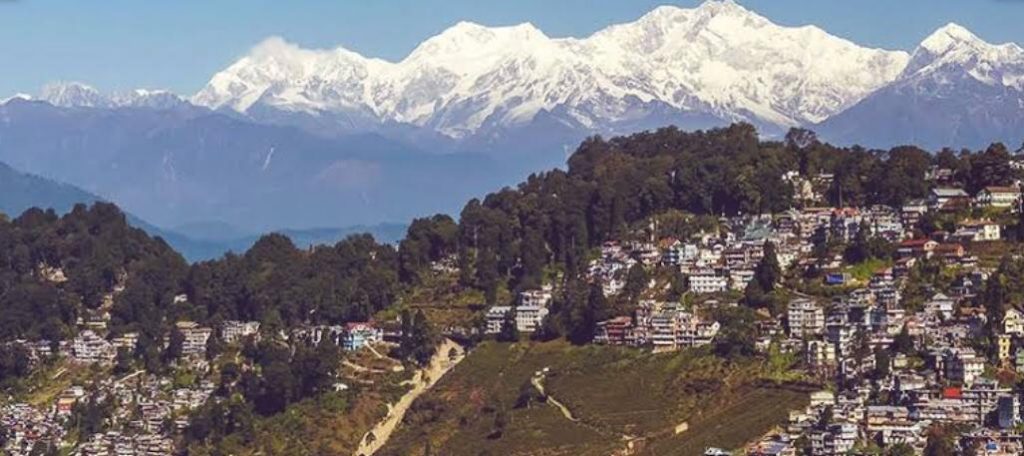 Darjeeling is a town in India’s West Bengal state, in the Himalayan foothills. Once a summer resort for the British Raj elite, it remains the terminus of the narrow-gauge Darjeeling Himalayan Railway, or “Toy Train,” completed in 1881. It’s famed for the distinctive black tea grown on plantations that dot its surrounding slopes. Its backdrop is Mt. Kanchenjunga, among the world’s highest peaks.
Darjeeling is a town in India’s West Bengal state, in the Himalayan foothills. Once a summer resort for the British Raj elite, it remains the terminus of the narrow-gauge Darjeeling Himalayan Railway, or “Toy Train,” completed in 1881. It’s famed for the distinctive black tea grown on plantations that dot its surrounding slopes. Its backdrop is Mt. Kanchenjunga, among the world’s highest peaks.
March 16: Darjeeling to Bagdogra by Jeep, Bagdogra to New Delhi by Air
NEPAL ADD ON 5 days
Tour Leaders: VJ Supera & Karma Tensum
Cost $1100 includes almost everything, including airfare from Kathmandu to New Delhi
The five day Kathmandu add on will combine meeting and socializing with old friends in Nepal, shopping, some down time and more visits to the fabulous stupas and monasteries in the Kathmandu Valley.
Expect new and often unplanned social and cultural experiences as we connect with old friends for dinner.
There is really a whole lot to pack in the 5 days in Kathmandu. While the tour will provide some planned activities, people are free to search/explore whatever they might want to do.
Day 1 Mar 16 : Flight from Bagdorgra to Kathmandu. Settle in Hotel Excelsion, Thamel. Explore Thamel, dinner at the Excelsior, Thamel
Day 2 March 17 : After breakfast at Thamel, take taxis to Boudha and visit the famous Boudha stupa. People can shop around the Boudha area and spend the day as they see fit. Dinner at restaurant at Boudha. Return to hotel by taxis.
Day 3. March 18 : FREE DAY to shop, explore, have a downtime OR Visit Bhaktapur.
Day 4, March 19: Breakfast at Hotel, taxis to the Swambhunath or the Monkey Stupa as it is called in some guide books. Hang prayer flags, circumambulate and
Day 5 March 20: Last minute shoppings, visiting Tibetan friends, farewell dinner…
Hotel is Excelsior Hotel, Thamel, Kathmandu, Nepal.
Excerpts of Testimonials from former participants
Pastor Dave Andersen
This tour was a pilgrimage and Karma lead by example. We spent lots of time circumambulating the various holy sights saying our mantras and counting with our prayer beads. The peacefulness of the settings was powerful even with the presence of so many pilgrims. In other moments I found myself in conversation with Buddhist practitioners who, like me, were astonished and moved by being at the holy sites of the Buddha’s birth, teachings and ministry. More importantly, there were moments of laughter, sharing and gentleness. Our tour professionals from Multivision Tours, Raj Madaan and son, provided excellent accommodations, safe transportation, incredible food and frequent opportunities for rest and relaxation. It was in many ways a life-changing experience.
Roberta Anderson
I can’t say enough good things about the Footsteps of the Buddha Tour. I have done several other pilgrimages in India over the years, and this tour was up there with the very best I’ve been privileged to get in on.
I also appreciated having such beautiful and comfy hotels to come home to after our very full days visiting various holy sites. . Both the Palace on the Ganges and The Royal Residence in Bodhgaya were some of the nicest hotels I’ve ever stayed in.
I think that the thing that made this trip truly special for me (and very different from a “sightseeing tour”) was the strong spiritual focus–the ongoing discussions on The Four Noble Truths which continued after Sarnath, and counting mantras as we circumambulated the Great Stupa in Bodhgaya and also on the bus rides. And I will always remember having the Karmapa Skyped in to that huge tent filled with chanting monks.
Steve Rumley
I think the Footsteps concept is a compelling reason to join up for this tour, especially when you realize you’re actually experiencing tangible historical sites that are evidence of the existence of this man, who has affected the lives of billions ever since. It made real, what happened at these places: the Buddha’s birth, his death, first and last teaching, where he became enlightened… The tour also provides the opportunity to experience the remarkable country that is India.
Tsering Gyatso
Doing the four major pilgrimage sites of Sarnath, Bodh Gaya, Kushinagar and Lumbini is the hope and dream of every Buddhist. To undertake this pilgrimage in the company of the TCEF group and in the comfort that the tour provided was an amazing experience. I’ve visited some of the sites before and had no idea that such great properties existed on this travel route.
Each and every site was special. As a pilgrim, I was delighted that the tour gave everyone the time and personal space to make every site memorable. That way, I was able to soak in the blessings of these special places.
VJ Supera
I have been going to India for over 50 yrs and have made so many trip- I can’t even count them .. but the footsteps of the Buddha tour took me to places that I had never been
TCEF knows better than anyone how to do India and Nepal. Don’t miss a chance of a lifetime! Sign up for this tour!
Joan Bird
The Footsteps of the Buddha tour was eye-opening and heart-opening in ways I had not imagined. Though I am not Buddhist, I have certainly benefited from Buddhist teachings and had always wanted to visit Bodhgaya, and the Bodhi tree where the Buddha awakened. This was just one of the major Buddhist pilgrimage sites we visited. Not only did we get an introduction to India, and some of its great holy places, we learned a great deal about Buddhism and the vast richness of this wisdom tradition.
For first-timers in India, traveling with an experienced guide makes it all so much easier. Karma Tensum, Indian guide Raj, and a phenomenal bus driver did a great job of shepherding us through all the challenges of foreign travel and helped make the experience comfortable, safe and fun.
The visit to Clement Town and Kyitseling was a highlight of our trip. This Tibetan refugee community has a peace and aesthetic that was enchanting. The beautiful stupa, monastery and adjacent nature preserve all add to the quiet charm of this town. And getting to see Kyitseling and meet many of the students was a sweet part of the trip. One definitely comes away with a sense of Tibetan culture, the great education these children are getting, and the gifts the Tibetan diaspora is spreading around the world.
Tour Leaders:
 Karma Tensum
Karma Tensum
Karma was born in Tibet but raised in Northern India. Born into a Tibetan refugee family his life was transformed by an education made possible by the wisdom of HH The Dalai Lama and the early Tibetan leadership in exile coupled with the compassion of kind sponsors.
Karma’s life experiences is custom-built to lead this Footsteps of the Buddha tour in the heartland of India. Raised as a cultural Tibetan, he is a practicing Buddhist. Educated in India he has a Master’s in Indian History and Culture. Having lived in the West for the past 17 years he can share Buddhist philosophy or Indian history in a way that can relate to Westerners.

Winter Safronoff
Winter has been traveling internationally since she was in her teens! She learned the ropes of international travel as an apprentice to India Supera over many years. That, coupled with her innate flair for handling logistics makes her an invaluable tour member and leader. She loves the country of India, has a natural affinity for most things India and also totally loves the Tibetan and Buddhist cultures.
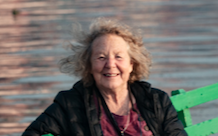
V J Supera
V J’s experience as an international travler is second to none! She has traveled to India and Nepal more than 50 times. She loves the people and place of Nepal. She has contacts and friends built over a life time of adventures and is one of the funnest peoples to travel with.
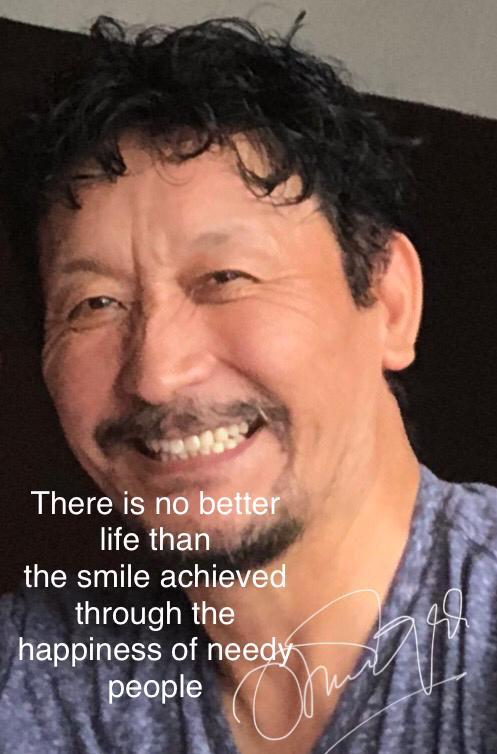 Tseten Dorjee
Tseten Dorjee
Tseten is a master Tibetan thangka painter. He was one of the three thangka artists who TCEF invited for a series of exhibition tours in 2005. He lives in Gangtok, Sikkim and speaks fluent Nepali, the local language.
Tseten loves to travel, to be happy and to make everyone around him happy. In this journey to the Himalayas, he will be our close friend and local contact, getting us as close as anyone can to the flavor and culture of this special place.
Registration Information
Cost for the above itinerary:
$3,500 USD per person, double occupancy (excluding all international airfare)![]()
*To pay by check and save credit card charges, please send an email to tcef@mt.net or call (406) 461-8745.
An $800 NON-REFUNDABLE deposit is required to hold your space. Final payment is due December 31, 2019.
Participants are responsible for booking international flights and getting required visas. We request that you not book your international tickets before December 31, 2019 or till you get clearance to do so.
Rooming: If you want a double room we will try to match you with a roommate. It sometimes happens that we are not able to do that – in that case you will have to purchase a single supplement.
TCEF FOOTSTEPS OF THE BUDDHA TOUR MARCH 2020
INITIAL REGISTRATION INFORMATION
Simply email tcef@mt.net with the following information
1.Name
2. Address
3.Email
4.Telephone
5. Deposit $800 payment method. Please indicate ONE from options below:
a)Online payment using PayPal
b) Mailing a check in favor of TCEF to PO Box 1403, Helena, MT 59624
c) Will call with Credit Card Number
INCLUDED IN YOUR TOUR:
— Traditional welcome
— Welcome drink
— Arrival-departure transfers by ac coach
— All sightseeing by ac coach as per the program
— Daily breakfast & dinner
— Monument entrance fees
— Boat ride at River Ganges
— English speaking guide and escort
— Hotel accommodation on twin sharing basis
— All domestic flights
COST DOES NOT INCLUDE:
—International Air
— India & Nepal Visa Fee
— Any expenses of Personal Nature
— Tips & Porterage
DOCUMENTS:

You must have your passport and visa before you leave the US. India has now outsourced its visa issuing to Cox & King Global Services (516-206-1483 / 646-589-0088). Expect the entire process to require 2 – 4 weeks. Your passport is ok if it does not expire before April 30th. Foreign nationals are allowed to apply for a 10-year tourist visa. (They will automatically issue you a multi-entry one, so those going on to Nepal needn’t worry about the return to Delhi.) We will get our Nepal visas at the border for the extension.
The application form asks for a reference in India. You may use our tour operator Raj Madaan:
RAJ MADAANMULTIVISION TOURS & TRAVELS (P) LTD.
A -125 Katwaria Sarai, New Delhi, India 110016
It’s a good idea, prior to departure, to send yourself an email with your passport numbers and any other important numbers – like credit cards, traveler’s checks, etc., so you can retrieve them easily if you need them. Also, scan the inside front page of your passport, and the page with the visa stamp, and email it to yourself. SEND us a good quality photocopy of the inside front page of your passport and the visa page, or a good, legible scanned copy. Having this will speed up replacement should that ever become necessary.
AIRFARES:
We are in the process of investigating the best airfare for both international travel and in-India air-travel. Upon securing the best rates, we will contact those who have registered to book air flights accordingly.
TRAVEL INSURANCE:
You must have travel insurance! If you think you can’t afford it, just think of the financial consequences if you don’t have any and something goes wrong. Make sure your insurance covers health care, theft of property, lost luggage, travel delays. Over many years of travel in India and the surrounding area, I have used every one of those coverages at one time or another. We are traveling in safe places, not doing dangerous things, but you will want to know that if anything were to happen, you would be covered. Then you can travel with your mind at ease, and so can we.
We recommend Travel Guard Insurance www.travelguard.com which can be purchased on-line.
HEALTH OF THE BODY:
There are allopathic doctors everywhere and good doctors in the cities. I have every confidence in the medical professionals I know in communities there. We do ask you to do a few things in the month before we depart to help your body gear up:
Continue with whatever daily vitamins you are currently taking, with the addition of a good probiotic (Renew Life or Nature’s Way Optimum are good ones). Begin taking “CoQ10” – an enzyme that helps oxygenate your heart and head. Begin taking extra Vitamin C. Taking Acidophilus regularly – starting a month before you leave – will keep your intestines happy.
Most of all, PLEASE TALK WITH YOUR DOCTOR BEFORE YOU GO AND FIND OUT WHAT SHE OR HE RECOMMENDS FOR YOU. Check out any developments on the Center for Disease Control website at: www.cdc.gov. In particular, ask about:

VACCINATIONS:
Hepatitis: There are vaccines for both Hepatitis A and B. (Having had hepatitis, I think you may be happier if you take the shots.)
If needed, booster doses for tetanus, diphtheria and measles, and/or a one-time dose of polio for adults.
Talk with your doctor about everything mentioned above, and also about taking along a full-spectrum antibiotic, like Cipro (Ciprofloxacin), in case of dysentery, and Lomotil for diarrhea. (You will also want to take along some “Emergen-C” packets – the electrolytes will help if you get diarrhea.) We recommend that you wash your hands frequently, and bring along a small bottle of alcohol-based hand sanitizer. (Only bring ONE small bottle – it lasts and lasts!)
NOTE: Rabies is widespread in Asia. Rabies treatment is now a series of 3 shots. If you get bitten you have to take them. You can usually tell a rabid animal — it looks and acts crazy – but don’t be friendly with the numerous dogs. If you’re afraid of a dog, pick up a rock and throw it. If you want to feed dogs, like I always did, just put the food down in the street. (Beware of the monkeys, too – they can be very aggressive.)
AIRPORT SECURITY PROCEDURES:
These rules change periodically so please check with your airline. All liquids and gels in your carry-on bag must be in bottles no larger than 3 oz., and these bottles must be inside ONE clear quart-sized Zip-Lock-type bag. (Don’t carry any sharp and dangerous weapons of terror and mass destruction (like tweezers) in your carry-on bag.)
LUGGAGE AND PACKING:
We recommend that you fit all your personal items into one pull-along suitcase that you can handle easily yourself. We will have porters everywhere, but you should be able to handle it yourself just in case. Inside that suitcase bring a light duffle bag for things you purchase along the way. The in-country flights have a 35 lb weight limit. Use security-style luggage locks — the kind that the security people can unlock with their special keys. This way your bags may remain locked in transit. We are happy to help you decide what to bring.
PLEASE HAVE YOUR LUGGAGE VERY CLEARLY MARKED AND EASY TO IDENTIFY. Prior to boarding your domestic flights in India, as you leave the main terminal you sometimes may be required to identify your checked baggage as it’s being loaded. Failure may mean that your checked baggage will not be put on the flight. Unfortunately, this process is not followed by all airlines and at all departure points, SO PLEASE MARK YOUR LUGGAGE WELL.
CLOTHING:
Comfortable and modest clothing is the key. Bring flip-flops and whatever comfortable walking shoes you like. Sometimes when you take shoes off outside temples they disappear so don’t bring your most expensive shoes. There are some Hindu temples that forbid you to take any leather goods – such as belts, wallets and leather bags – inside the temple. Therefore keep leather to a minimum. Both men and women will need to cover their heads prior to entering a Sikh place of worship. You MUST bring a money belt that goes underneath your clothes for your passport, etc. Bring long pants, good walking shoes and changes of cotton socks. Dress modestly. We can easily get ready-made Punjabis and saris at any level of quality and price in India. If you are coming to Nepal we will have another list for you.
THINGS TO BRING:
Flashlight, batteries, day pack, water bottle, dental floss, tampax, watch, sunglasses, sun hat, insect repellent, something for the itches in case you don’t get the repellent on fast enough, any medications you need (prescription or otherwise). Electricity is 230-240V, 50 cycles, alternating current. (You will need transformers for electrical equipment.) Light rain gear will be good to have. In other words, bring anything you may need for your health and safety – bring it rather than relying on finding it in a culture vastly different from our own. There are internet cafes almost everywhere and our hotels will have internet. Bring only those yoga props you absolutely need.
 MONEY:
MONEY:
The currency is the Rupee. It is pretty easy to obtain in any hotel (in Delhi) or from readily available, but not always functional, ATM machines, etc. So, for the smaller towns, do bring some traveler’s checks, dollars in addition to debit/credit cards – it is easy to convert them into Rupees. Talk with your bank and credit card companies before you leave home and pre-arrange the amount you can draw or spend at any one time, so you don’t get stymied by an unexpected limit. (India is an absolute delight as far as what you can buy there – gems, carpets, saris, artworks, etc., costing up into the thousands. There’s no end of money you can spend in India – just decide what you might want to spend before you leave.) Everyone will charge you a fee to use credit cards.
ONCE WE’RE IN INDIA
AT THE AIRPORT IN DELHI:
When you arrive at the airport in Delhi, there are good ATM machines there. SO BE SURE TO GET YOURSELF $200 WORTH OF RUPEES BEFORE YOU LEAVE THE AIRPORT. That will handle your immediate needs without having to hassle with finding an operating ATM somewhere else.
You will be met at the airport. It will be something of a mob scene, whatever time you arrive. Walk out beyond customs with your luggage, and look for someone with a sign with your name and the name of our group on it. (Just in case you need help – Raj Madaan, our great friend and land agent, will be available by cell from the Delhi airport at 93 1121 1994.)

FEEDING THE BODY:
We will be eating mostly in hotels or at friend’s houses but everywhere we must take basic precautions. This will all be explained as we go along but the basic rules are: No salads, even in hotel buffets, peel any fruits or vegetables yourself; eat only hot foods, no ice. Bottled water only – inspect the seal, don’t drink from any bottle with a broken seal. Learn to love Indian food. India has the best food in the world. It’s a well-developed vegetarian diet. If you are attached to having some particular food, bring it along.
WEATHER:
We are visiting when winter is tapering out and Spring has still not arrived. Average daily maximum temperatures range between 10 and 28 degrees C (50 to 82 degrees F)
DRUGS:
It is part of the religious tradition in the North to incorporate things like hashish. Bhang lassi is a drink made from the leaves of marijuana with yoghurt. There is not a big judgment around this and you will encounter it. If you decide to experiment be wide awake and in a safe place. Intoxication makes you susceptible to robbery. My advice is the same as in the US: best left alone unless you’re in the proper circumstance for it.
SCAMS:
You may have heard about scams in India, but when you’re traveling with a group like ours, you don’t need to worry about that. By and large, India is a safe country in which to travel, and Sikkim and Bhutan even more so. (There are always going to be touts and commission agents around – that’s how the system works there, and they can be great helpers.) So don’t be going into India with the fear that you’re going to be ripped off. “Trust in God but tie up your camel.” Keep yourself healthy and keep your chi around you and you will be fine. (People are more vulnerable to getting robbed or cheated when they are tired.)

TIPS, GRATUITIES, GIFTS & ALMS:
I will collect the money for tips ahead of time. This way we can make sure to handle all of the gratuities and alms in the way that will best help the people in the communities you will be meeting, and you won’t have to worry about it at all. Visit the TCEF website (www.tibetanchildrenseducation.org) – our main charity in India. We also will handle all of the normal tipping for dining rooms and luggage, etc. Most people don’t know where to pay baksheesh, what bribes are needed, etc., and we do. I find it easiest to collect the money before we leave. It will be $200 per person for India. If you do see something you feel you’d like to give to, ask for my help to avoid scams.
BEFORE WE GO
BOOKS – INDIA’S SUGGESTIONS:
If you read only one book I recommend Freedom at Midnight, by Larry Collins and Dominique Lapierre. It’s based on the events leading up to independence from England and will give you a good political background for modern India.
— Arranged Marriage: Stories by Chitra Divakaruni
— The God of Small Things by Arundhati Roy
— A Fine Balance by Rohinton Mistry
— Anything by Khushwant Singh
— Death of Vishnu by Manil Suri
— A Million Minutes by VS Naipaul (Nobel Prize Laureate in 2001)
— Any book by Chetan Bhagat (The most read author of younger Indian world)
— Any book by Karin Desai
Spiritual readings: We’re going to be mostly in Tibetan Buddhist world, so you may want to read up on it. You may also want to read up on Hinduism in the Mahabharata, or any condensed version or the Ramayana.
MOVIES:
Classic and good include:
“Heat and Dust” is an older film that’s wonderful. I also recommend “City of Joy” and “Phoolan Devi: Bandit Queen.” Any film directed by Satyajit Ray would be great (www.satyajitray.org). Also “Salaam Bombay,” “Born Into Brothels: Calcutta’s Red Light Kids,” Directed by, Zana Briski. “Water,” “Fire,” and “Earth,” Directed by Deepa Mehta. (Mehta’s movies have scandalized India. She’s the closest thing to Satyajit Ray these days.) “Namesake” by Mira Nair. There is a very good film you can watch online about Dr. Babasaheb Ambedkar, who was one of the authors of the Indian Constitution, a low-caste Indian who rose to prominence. He became a Buddhist, and was responsible for the Neo-Buddhist movement in India. More popular and for fun include: “Bend it Like Beckham”, “Monsoon Wedding,” “Bride and Prejudice,” and “A Touch of Pink.” Also, “Slum Dog Millionaire.” Also “Three Idiots.”



